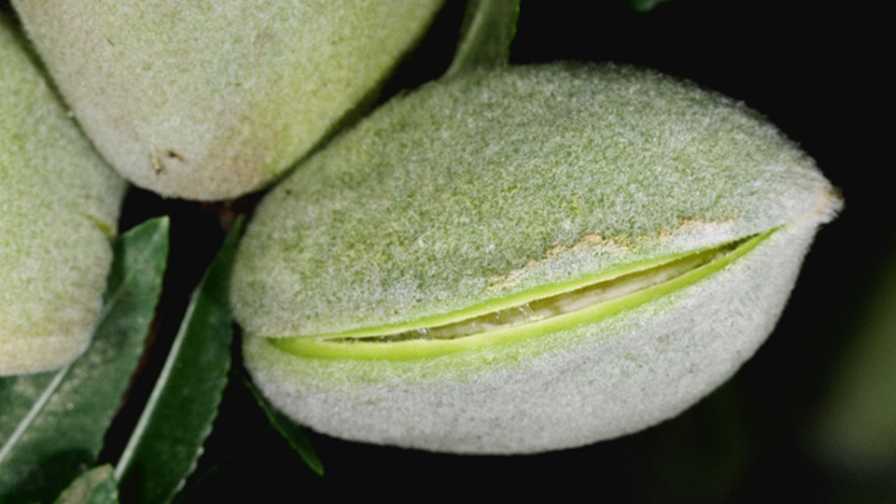Hull Split Spray Timing Is Essential for Healthy Almonds

Target for first navel orangeworm spray; stage 2c of early hull split in almonds. The nut can be squeezed from the ends, and the suture will pop open.
Photo courtesy of UC IPM program
Last fall, an experienced pest control adviser (PCA) in the Arbuckle area (Colusa County, CA) said, “If your first hull spray went out after July 4 last year, you weren’t happy with your reject sheets.” The exact date isn’t important as we look forward to the 2020 hull split, as every year is different. Take-home message: If you wait too long on your first spray, it doesn’t matter if it’s done by air, ground, or robot, or what’s in the tank, or how slow you drive, or what spray volume you use. You are too late to get the best control possible, and it will cost you in both lost crop and quality incentives.
Early hull split, when the hull begins to open at the suture (pictured above), is a can’t-miss timing in almond pest management. The splitting hull does two things: releases nut volatiles so the navel orangeworm (NOW) female can find the nut (and lay eggs); and it gives wound pathogens like Rhizopus stolonifera and Aspergillus niger an opening to infect the hull.
Spraying at the right time, when hull split first begins (in the upper, southwest side of the tree), is critical to effective Rhizopus hull rot and NOW management throughout the orchard. To get the timing right, get up in the tree in a pruning tower or bring the treetop nuts down to ground level with extension pruners so you can really see what’s going on. Splitting usually starts on the southwest side of the treetops.
Because getting the timing right for the first hull split spray is critical and takes time to get across orchards, consider: 1) spraying the edges from the ground as the blanks start to split in those edge trees; 2) going by air to get across the orchard(s) before the 2c stages end in the treetops; and/or 3) starting spraying by ground a couple of days before nuts get to 2c stage so you can finish quickly (in a week or less). A second application may be needed within seven to14 days based on trap counts and orchard damage history, with the interval depending on the material.
AERIAL ATTACK
For the first hull split spray, air application is effective and fast. Research by Dr. Joel Siegel, USDA-ARS Researcher at Parlier, CA, has documented good NOW control with careful aerial applications (fixed wing or helicopter) with spray volumes as low as 15 gallons per acre (GPA). He reports spray coverage by air is 20% to 25% less than a good ground spray job (150 to 200 GPA, 2 MPH), but control in the tree tops — where the nuts split first — is very good. Growers achieved 90% control in tree tops by air, though ground application was still superior, with 100% control.
To deliver good results, ground rigs must be calibrated and set up for excellent coverage. It is a lot like painting a large house. For good siding protection from weather, you need even paint coverage (no gaps). In almonds at hull split, the whole canopy, leaves and all, must be evenly sprayed to protect the nuts — to leave no gaps you have to “paint the whole house.” There are 4 to 8 acres of leaf surface area in an acre of mature, vigorous almond trees. Multiple studies in almonds from Colusa to Fresno have shown that 150 to 200 GPA spray volume from a ground application delivers better NOW control than 100 GPA.
Additional steps that help deliver the best coverage possible are as follows. Slow tractor speed — 2 mph — gives the sprayer fan time to move the spray material throughout the canopy. Check your ground speed using flagging tied to a PVC pole or window-washing extendable pole. If the flagging doesn’t move as the sprayer drives by with the fan on, slow down until you find a speed where the flagging just flutters out 45°F to 90°F off vertical. Also, target more spray material into the upper canopy by locating more and/or larger nozzles in the upper spray boom on each side of the sprayer. While the standard approach is two-thirds of the spray volume directed out of the top half of the open nozzles, I have had good luck, in tall trees, with sprayers set up to deliver 75% to 80% of the spray volume through the top quarter of the boom.
Regardless of whether you are spraying from the ground or hiring a plane/chopper, please note that spraying in dry, warm air (relative humidity below 40% and temperatures above 80°F) can reduce spray coverage due to rapid droplet evaporation. Losses of 50% spray deposition have been measured in treetops using a ground rig at 11:30 a.m. vs. 6:30 a.m. in June in the Sacramento Valley. Dusk to mid-morning is a good target window. Some aerial applicators are set up for night spraying.
Hull split is a critical timing for pest control in almonds. NOW and hull rot pressure have increased the last few years. Proper spray timing and delivery will help make reject sheet reading less painful and almond growing more profitable.










